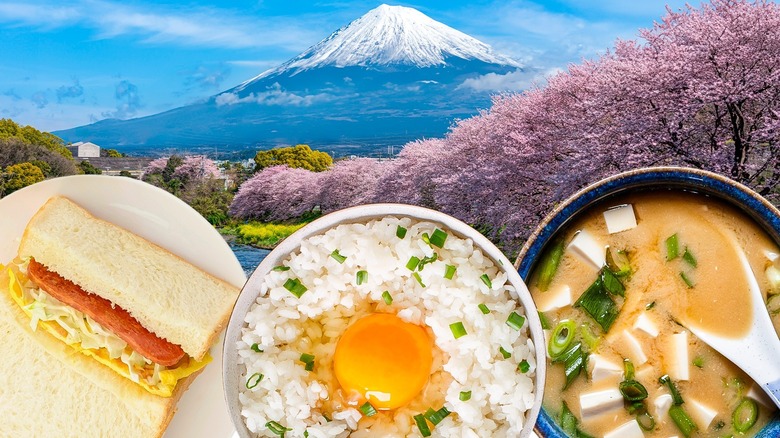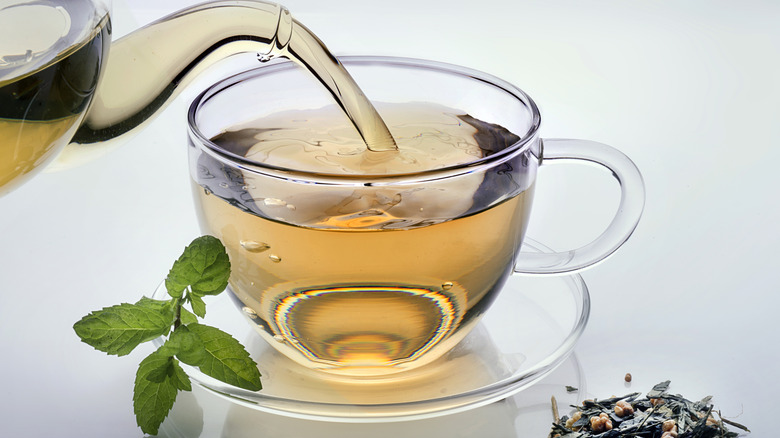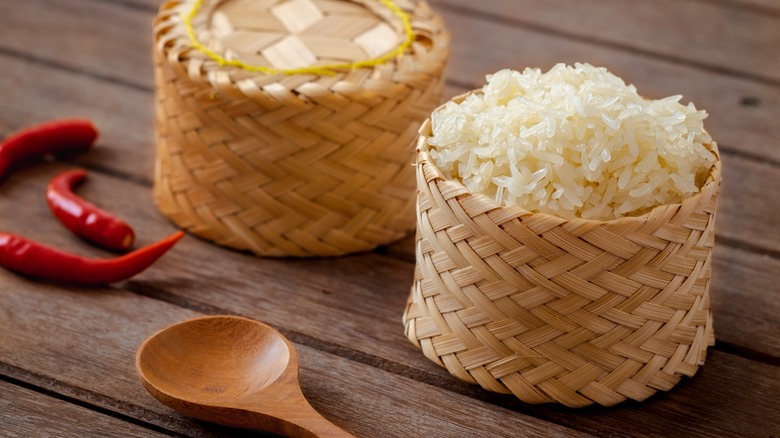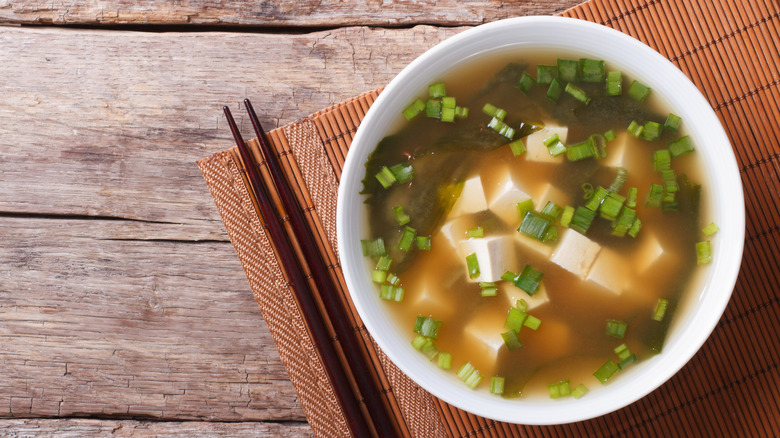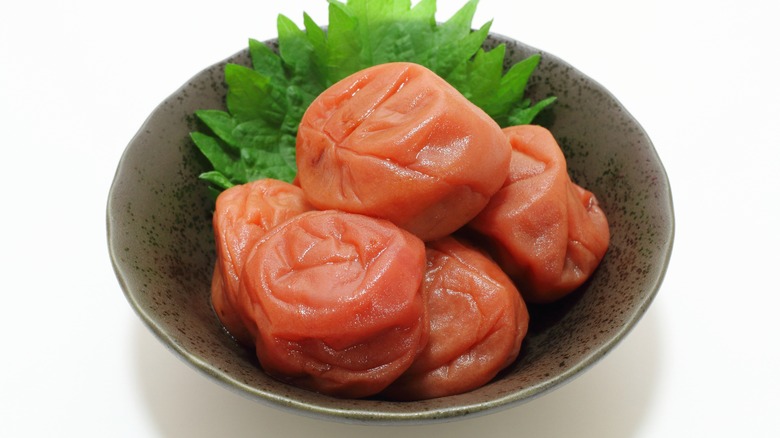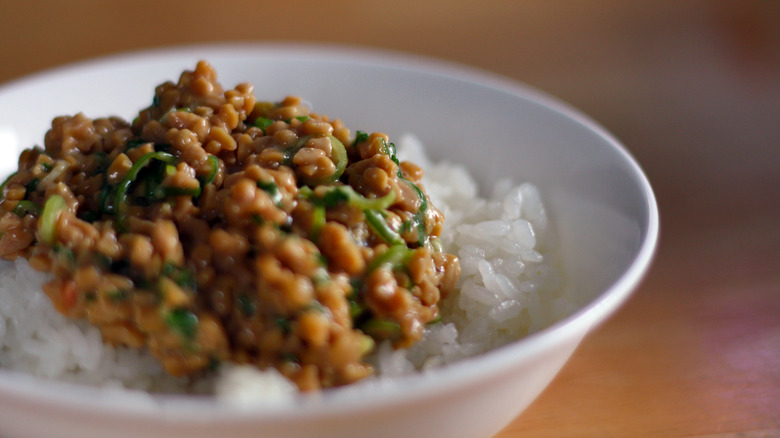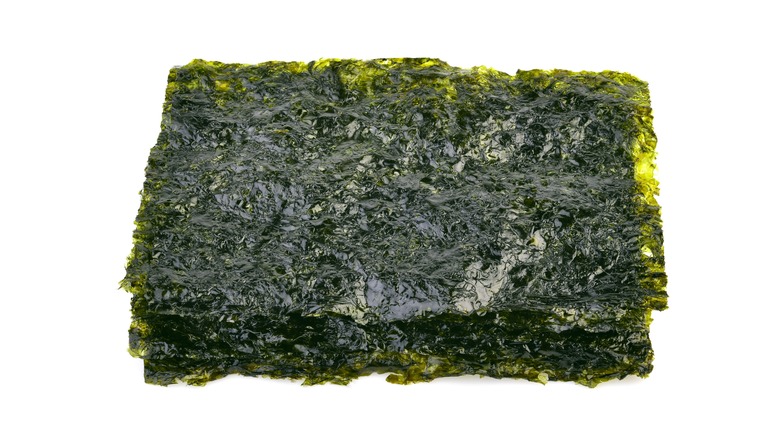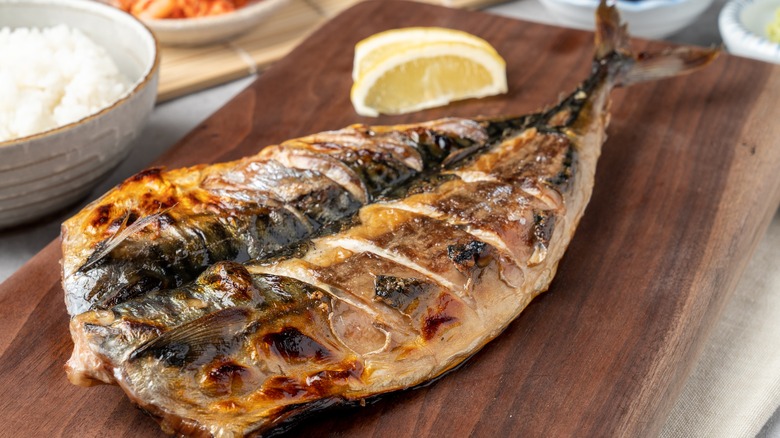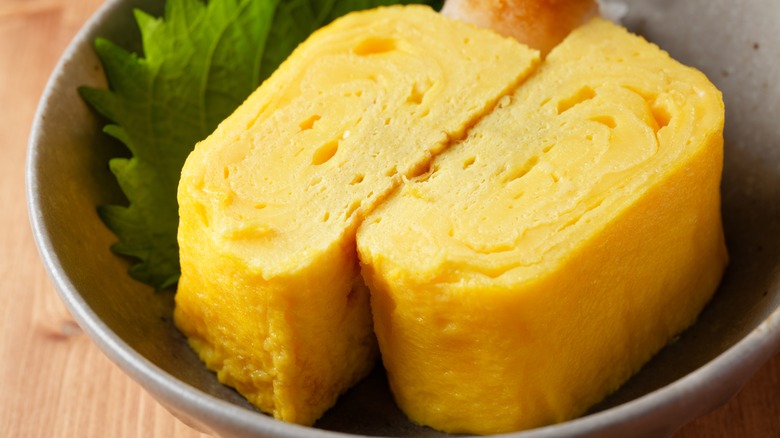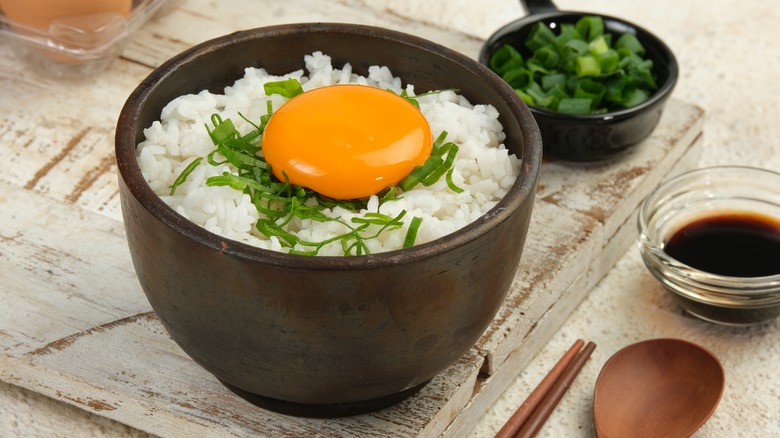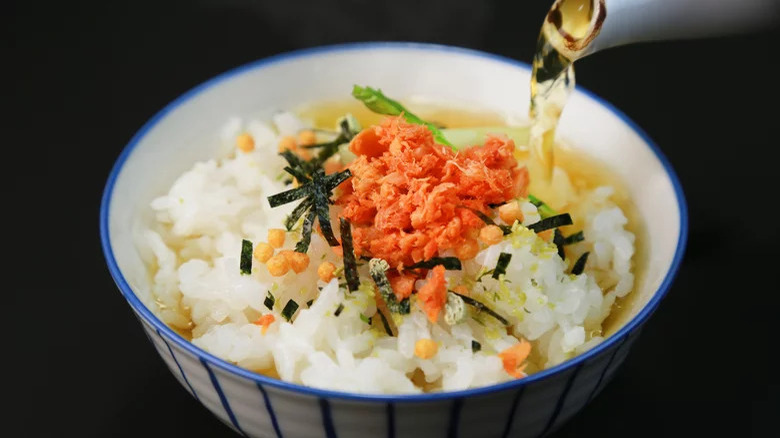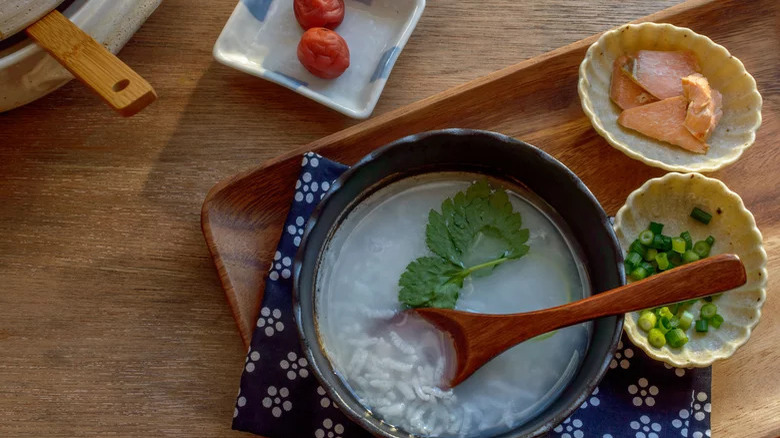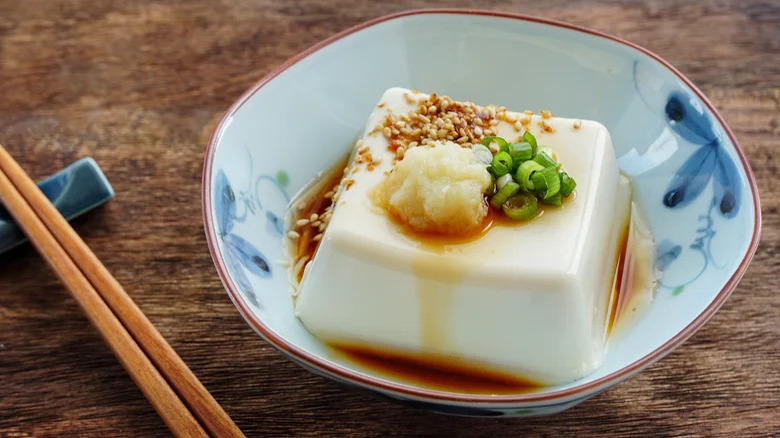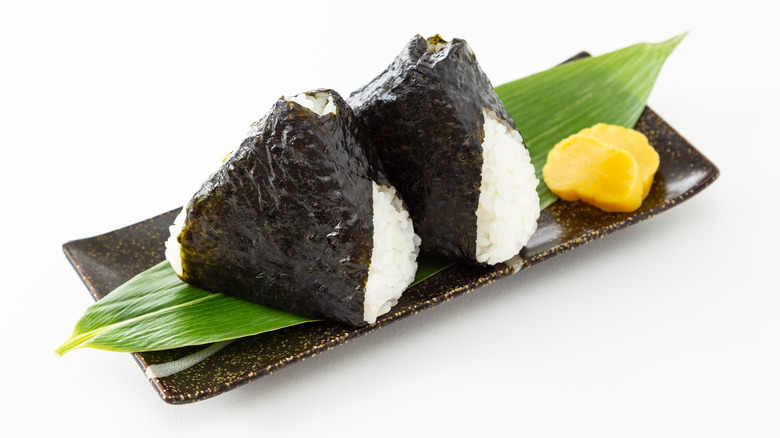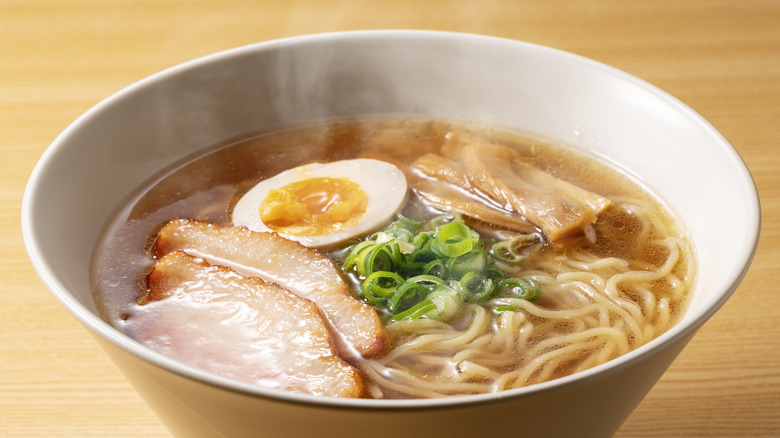14 Popular Breakfast Foods In Japan You Should Know
Breakfast staples can vary considerably from country to country. In the Western world, eggs are the star, with bacon, potatoes, syrupy pancakes and waffles, hot and cold cereal, and other filling staples. Breakfast in Japan, however, includes many foods also enjoyed for lunch and dinner. It is centered around a balanced selection of nutrients essential to a well-rounded day.
Philosophy is inherent to everyday life in Japan, even when it comes to breakfast. "Ichiju sansai" is the basic framework that informs how food is served in traditional Japanese cuisine, which is known as "washoku." The philosophy refers to meals composed of one soup-type dish, one main dish, and two sides. "Ichi" translates to one, "ju" to soup, "san" is three, and "sai" means dishes — "one soup, three dishes."
It's also a more nutritious way to start your day. Whether breakfast, lunch, or dinner, ichiju sansai provides carbohydrates for energy, pickled foods for improved digestion, protein-rich meats and seafood, and veggies for vitamins, minerals, and fiber. Because of this approach, traditional Japanese breakfast is largely indistinguishable from lunch and dinner. It's evolved over the years, though, and today incorporates Western staples, too. To explore Japan's unique take on morning meals, we have fervent home chef Yuka Allen to help us. Born and raised in Japan, she has first-hand experience with popular Japanese breakfast foods you should know.
Green tea
Coffee is America's favorite morning booster, but in Japan, green tea kicks off the day. There are several varieties of Japanese green tea. Matcha, sencha, and genmaicha are a few popular types. Tea, or "cha," is traditionally served in a teacup (or yunomi), which is set atop a saucer or small tray and held with both hands when enjoyed. Locals consume this ancient beverage throughout the day for its life-supporting benefits. According to Statista, it's the number-one tea variety in the country.
Green tea has been used to improve mental alertness, alleviate digestive issues and headaches, and promote weight loss for thousands of years. Along with the aforementioned types, other popular varieties include gyokuro and hojicha. Each varies in how they are cultivated, which impacts taste, aroma, and caffeine content. All Japanese green teas contain some level of caffeine, which is great for sluggish mornings. That said, many locals drink coffee for breakfast as well. It's still considered a Western tradition but is widely available at kissatens (Japanese tea-drinking shops), ryokans (Japanese inns), convenience stores, and even in vending machines.
Steamed rice (gohan)
You might be surprised to learn that steamed rice, known as "gohan," is an essential Japanese breakfast staple. Locals eat rice around the clock, and Japan is known to produce 300 variations of the grain. When it comes to sticky rice, the Koshihikari variety is the most popular. It has a subtle sweetness, starchy texture, and shiny appearance, and is not the same thing as sushi rice. Other common sticky rice types include Akitakomachi, Nanatsuboshi, Hitomebore, and Hinohikari; each has distinct characteristics. Akitakomachi is light and easily digestible and the one many say is the best for breakfast.
"Both of my children now prefer gohan for breakfast, instead of toast. I usually don't eat breakfast now but I like gohan when I'm on trips staying at breakfast-serving hotels or inns with natto, nori, yakizakana and misoshiru," Yuka Allen says. Rice provides carbs like toast and potatoes do in the West. It's typically served plain and paired with other dishes. Locals like to spruce it up with flavorful furikake, which is a combination of nori seaweed, shiso herb, and roasted sesame seeds — though other blends exist as well.
Miso soup (misoshiru)
Misoshiru is one of the most widely consumed soups in Japan. Umami-rich and sea-infused, it's a traditional soup enjoyed from sunup to sundown. The taste comes from a fermented paste made of steamed soybeans, salt, water, and Koji, a fungus cultivated for culinary use and the country's "national fungus." While mostly associated with sushi restaurants in America, in Japan, miso soup is a simple recipe for breakfast too. "Misoshiru is usually paired with gohan in my house. I make mine with two or three different veggies and tofu because that's how my mother always makes them more nutritious," Yuka Allen added. Along with being one of the country's ubiquitous flavors, it offers a range of vitamins and minerals like manganese, copper, zinc, iron, calcium, and more.
Thousands of miso paste varieties exist, but there are three main categories: white, red, and yellow. Red is fermented longest and packs the most robust flavor, yellow follows, and then white is the mildest. They can be made from either rice, barley, soy, or a blend of the three. Japan has many regional styles of miso soup. Some are made with salmon and potatoes and others with crab and ginger. Misoshiru is not only the most common, but it's the one most often eaten for breakfast.
Pickled veggies (tsukemono)
Pickling and fermentation have been practiced in Japan for centuries. Adding a refreshing zest, pickled foods are delicious and nutritious, and come in many varieties and styles. Napa cabbage, ginger, Daikon radish, umeboshi (plum), and eggplant are popular types. They vary in flavor, texture, and presentation, and pair perfectly with gohan (steamed rice). "Tsukemono" is an umbrella term for pickled and fermented foods in Japan, under which there are several sub-categories. "Oshinko" refers to lightly pickled vegetables infused with salt or vinegar brine. They are the pickled vegetables you should add to your breakfast plate.
"Nukazuke" is another common vegetable pickling style. Unlike Oshinko, it uses roasted rice bran (or nuka), in place of salt and vinegar. The process can take anywhere from a few hours to several months. "I now make nukazuke, a kind of tsukemono, at home, trying to increase fermented food intake for health reasons," Yuka Allen shares. Pickled and fermented foods are loaded with antioxidants, great for morning digestion, and an excellent source of vitamins and minerals – another reason to try traditional Japanese breakfast.
Fermented soybeans (natto)
One Japanese breakfast food that you'll either love or hate is "natto." It's even an acquired taste for locals. Don't let the cute name fool you, natto is a fermented soybean dish known to pack a pungent punch. It has a savory, nutty profile and looks like baked beans covered in a sticky substance that stretches like cheese. The texture may take first-timers some getting used to, but the flavor is remarkably mild when paired with rice. Yuka Allen adds, "I grew up in the northern part of Japan where natto is commonly consumed, and my father always served natto for weekend breakfast with tons of chopped fresh green onion and katsuobushi (bonito flakes)."
A versatile ingredient that's protein-rich with probiotic benefits, natto is an essential Japanese breakfast food for good reason. Probiotics, in particular, are known to improve gut health. It's primarily blended with rice but can also be topped with ingredients like soy sauce, green onions, poached eggs, pickles, and others. Dashi seasoning is another tasty topper. It's made with dried seafood broth and karashi (Japanese mustard). Pre-made store-bought natto usually contains a packet of dashi. Natto is a versatile ingredient that can add flare to many of your favorites.
Roasted seaweed (several names)
As an island surrounded by abundant ocean life, it's no surprise that seaweed is a common ingredient in Japanese cuisine. It's intensely salty with an unmistakably aquatic flavor that's surprisingly versatile. Popular foods like sushi, rice balls, miso soup, and ramen only scratch the ocean's surface. A deep dive reveals that locals enjoy seaweed for breakfast too. Fun fact: Seaweed is an umbrella term for over a hundred edible varieties. Nori, kombu, hijiki, and wakame are the most widely consumed in Japan.
It's traditionally eaten with gohan (steamed rice) for breakfast. "Dipping an edge of nori in soy sauce and wrapping it around hot gohan is unassumingly simple but makes a great flavorful breakfast," Yuka Allen adds. You can also wrap toasted nori sheets around Japanese breakfast staples like rolled eggs (tamagoyaki) and grilled fish (yakizakana). You can't go wrong with an energizing bowl of breakfast ramen (asa ramen) either. Or you can keep it simple with a filling rice ball (onigiri). Seaweed not only imparts fishy flavor into dishes, but it is also a great source of iodine, supports thyroid function, and may improve your gut and heart health.
Grilled fish (yakizakana)
A well-rounded Japanese breakfast wouldn't be complete without yakizakana, or grilled fish. It's protein-rich like natto, and, surprisingly, it is consumed in the country more than raw fish. Fish types like salmon (sake), mackerel (saba), sardines (iwashi), whitebait (shirasu), and mackerel pike (sanma) are morning favorites. They were traditionally grilled over charcoal, but cooking in a pan or broiling in an oven is just as common nowadays. "Although I don't cook them for breakfast at home, I love a piece of saba or sake shioyaki with white rice while I'm traveling," Yuka Allen says.
Japan's grilling style is all about simplicity, and that goes for the seasoning, too. Japanese cooks and chefs traditionally use only salt, or pairings like soy sauce with wine vinegar, soy sauce and mirin, or miso and sugar. The savory flavor of grilled fish goes great with tangy pickled vegetables, too. It's definitely a Japanese breakfast dish you need to try at least once.
Rolled eggs (tamagoyaki)
Eggs play a prominent role in Japan's food scene, but for breakfast, "tamagoyaki" is the style that most prefer. Fluffy and tender, the beloved dish is made with beaten eggs fried and then rolled into thin sheets. It's usually seasoned with a simple blend, but there are many ways to add flavor — from fish stock and sugar to soy sauce, or customized with ingredients like American omelets. There are no limits to what ingredients complement this egg-tastic treat. Grated radishes with soy sauce are common, along with green onion, seaweed, and eel. You can also mix tamagoyaki into rice or put it on a sandwich.
Whether sweet, savory, herbaceous, or with pickles, tamagoyaki is one of the best parts of the Japanese breakfast experience. This must-try custardy sweet tamagoyaki recipe is unlike any egg dish you'll find in America. Or you can simply put a Westernized spin on it with cheese and bacon. As you can imagine, ketchup tastes awesome on tamagoyaki, easily one of the best egg dishes from Japan.
Egg and rice bowl (tamago kake gohan)
Another popular egg dish is "tamago kake gohan," or egg on rice. It's not only a breakfast favorite but one of Japan's most famous comfort foods. A raw egg is cracked into a steaming bowl of hot rice and then drizzled with soy sauce. When stirred together, the pairing is a tasty way to fill up on protein and carbs. Piping hot rice partially cooks the raw egg, giving the dish a creamy consistency like risotto.
"[Tamago kake gohan is] another childhood weekend staple breakfast in my upbringing, and my kids seem to love it too. I know eating raw eggs is unthinkable for many Americans," Yuka Allen adds. Aside from soy sauce, tamari, MSG, and furikake are also flavoring favorites. It's a dish with few limitations, though, so it goes with crumbled roasted nori, sesame seeds, diced green onions, pickled ginger, and more.
Submerged in tea rice (ochazuke)
Tamago kake gohan is not the only Japanese dish that is considered a breakfast and comfort food classic, ochazuke is another. It means "submerged in tea" rice, and is literally that, though nowadays it is also made with dashi. Leftover rice inspired people to develop the idea centuries ago. They discovered that soothing tea-over-rice was the perfect dish. Tea and rice were affordable and accessible ingredients, so ochazuke naturally grew in popularity. The leftover rice is steeped in steaming green tea, which gives it a creamier consistency and imparts toasted earthiness. Savory ingredients like grilled fish, nori, and roe are frequent flavor additions.
Tea can also aid digestion. "My mother likes to pour hot tea in a small amount of rice in a bowl she can't finish otherwise. She likes to put in salty sakekawa or umeboshi," Yuka Allen recalls. Dashi-flavored ochazuke follows the same steps but is for those who prefer a seaweed-infused kick. It's especially satisfying in the morning after a night on the town.
Rice porridge (okayu)
When it comes to mindful cuisine, few countries do it better than Japan. Food there isn't only for enjoyment, it takes into consideration your well-being. Okayu is a simple rice porridge dish that people eat when under the weather. It's made with rice and water and has an easily digestible consistency. "Okayu would be great when your stomach isn't feeling too good," Yuka Allen says. Along with a tender texture, it offers restorative benefits and has a neutral profile that you can flavor with countless ingredients. "I like to stir in a raw egg and cook a little with seasoning," she adds.
Toppings like nori, sesame seeds, green onion, umeboshi, grilled fish, eggs, and vegetables are common flavor boosters. Dashi or chicken stock can be used in place of water to add flavor, too. Japanese people consider okayu a healing food, though, so it's typically kept plain-ish despite having versatile potential. Because okayu is ideal for cold symptoms, it's mostly enjoyed as a Japanese winter food.
Side dishes (kobachi)
Kobachi, or "small bowl," refers to Japanese side dishes. You won't find a more impressive selection of sides than what Japan offers. Commonly sold at sushi restaurants in the United States, Japan, however, serves kobachi for breakfast as well. The word actually refers to the serving bowl itself, rather than the sides. Locals use it interchangeably, but mostly to describe the various foods. There are many types of crave-worthy kobachi, enough to keep you busy in the kitchen. The extra time it takes to prepare them is perhaps the only downside.
Yuka Allen brings up an important point: "A stay-at-home wife/mom may serve several kobachi dishes with gohan and misoshiru for better nutrition. If you are a working mom, you probably opt out of the extra steps at home and enjoy them when you are eating out or staying at hotels/inns." Nonetheless, kobachi is a popular part of breakfast in Japan. Some sides include crispy-fried lotus root, vegetable tempura, salad, pork-wrapped eggplant, and hiyayakko, which is cold tofu seasoned with soy sauce, garlic, spring onions, and other ingredients. Whether you prefer refreshing to savory or sweet to spicy, there is a kobachi for you.
Rice balls (onigiri)
Onigiri, or rice balls, are hands-down one of the best ways to introduce someone to Japanese cuisine. They are genius culinary creations that have been satisfying stomachs for hundreds of years. More specifically, onigiri are nori-wrapped rice balls stuffed with ingredients. Fillings can range from kombu (kelp) and umeboshi to seafood, vegetables, kimchi, and much more. There's no better way to start Monday, and what's more, onigiri is super cheap and the perfect on-the-go treat. If you don't have time to cook breakfast in the morning, it's widely available at convenience stores, supermarkets, and specialty shops in pre-made and fresh forms.
"Onigiri to me is for a lunchbox, but warm, freshly made onigiri with nori wrapped around is really good for breakfast too," Yuka Allen says. To say that it's popular in Japan is an understatement. There is an onigiri location that has a 3-hour wait. Yumiko Ukon, resident Onigiri Master of Onigiri Bongo, uses inventive fillings like beef curry, bacon and cheese, fried chicken, pork kimchi, and pepperoncino. You can bring the same adventurous spirit to breakfast with bacon and eggs-stuffed onigiri.
Morning ramen (asa ramen)
A newer breakfast trend in Japan is morning ramen, known as "asa ramen" or the short form "asa-ra." Though normally associated with lunch and dinner, morning ramen has been around for hundreds of years. It's served at restaurants as an energizing option for early-morning workers. Japan is known for having a highly intense work culture, so quick breakfast options are important. Shida ramen is the most popular breakfast style. It's named after the place where asa ramen originates, the Shida District, and is a bonito and soy sauce-based soup that includes char siu meat, served with hot and cold noodles. The soup has a subtle sweetness and comes with pickled ginger and spicy wasabi.
There are many styles of asa-ramen. Ohayo Gozaimasu style includes ingredients like bacon, avocado, tomatoes, enoki mushrooms, and poached eggs — a decidedly heartier alternative. What better incentive to get your Japanese ramen-fix for breakfast, lunch, and dinner?
